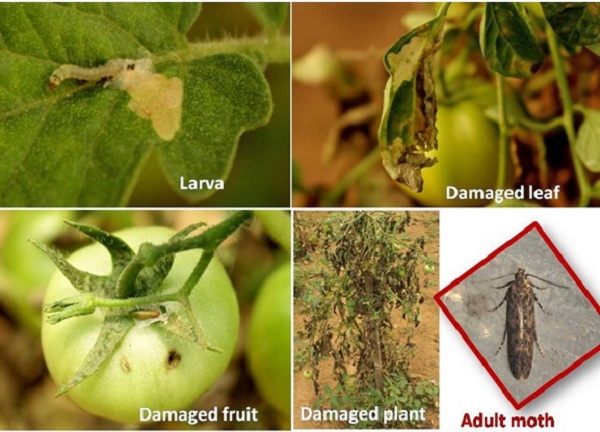New Invasive Pest Alert in NE India
Invasion of South American Tomato Pinworm, Tuta absoluta (Meyrick) in northeastern India
The tomato pinworm or leaf miner, Tuta absoluta (Meyrick) (Lepidoptera: Gelechidae) is a notorious pest of tomato (Solanum lycopersicum L.) throughout the World, that causes losses to tomato crops in the range of 50 to100%. Due to its short generation time and ability to develop resistance to insecticides, it attains the key pest status even in the new habitats and which has threaten successful tomato production systems across the world. This pest is native to Peru and also widespread throughout South America. During the last five years, it has been spreading rapidly in parts of Central America, Europe, Africa, the Middle East and Asia (CABI 2016; IPPC 2017). In India, T. absoluta was detected for the first time during October 2014 in central-west (Maharashtra) and south-west India (Karnataka state). Recently, the infestation of T. absoluta was observed in tomato plots at experimental farms of ICAR Research Complex for NEH Region, Umiam and adjoining areas of Ri-Bhoi district of Meghalaya during January 2017. The identification was confirmed by standard morphological characters and DNA barcoding by using cytochrome oxidase gene (CO-I) of mitochondrial DNA. The identity of T. absoluta successfully established at molecular level and the barcode sequence has been deposited to the NCBI vide accession number KY923648. As per the existing primary scientific literature, this is the first report of T. absoluta from eastern and northeastern regions of India. The detail report on ‘Invasion of T. absoluta in NE India’ has been accepted for publication in the research Journal “Entomologia Generalis”
The larvae were found infesting leaves and fruits of tomatoes. Larvae feed on mesophyll tissues in between upper and lower leaf epidermis and causing mines or blotches on the leaves. Infested fruits had pinholes, and larvae were found feeding on the pulp, leading to secondary infection by the pathogens. Considering the pest status, timely monitoring would be required to understand the bionomics of this new pest on tomato in its new habitat. Due to rapid multiplication and lack of natural enemies, T. absoluta may be more serious in new areas and cause significant economic losses to tomato and other solanaceous plants.
Infestation of Tuta absoluta on tomato plant
Following action management plan has been suggested by the NBAIR, Bengaluru for the management of this pestRapid action management plan advocated to farmers
- Destruction of infested tomato plants and fruits by burying deep inside the soil or by burning.
- Crop rotation with non solanaceous crops.
- Nursery with pest proof net covering and use of pest free seedlings for transplantation
- Preservation / augmentation of natural enemies like Nesidiocoris tenuis, Necremnus sp., Orius sp. and Trichogramma spp.
- Installation of T. absoluta pheromone baits for monitoring and mass trapping male moths both in nursery and main field (40 traps /ha)
- Initiate the use of insecticide both in nursery and main field, if the moth catches in the pheromone trap is exceeding 20-30 moths/trap / week.
- Recommended the following insecticides Chlorantriniliprole (Rynaxypyr) 10.26% OD @ 0.3 ml/lit or Flubendiamide 20% WG @ 0.3 ml/lit or Indoxacarb14.5% SC @ 0.5 ml/lit or Imidacloprid 17.8% SL @ 0.4ml/lit or Neem formulation (Azadirachtin @ 1% or 5%) @ 2-3 ml/lit) for managing the pest on tomato crop.
